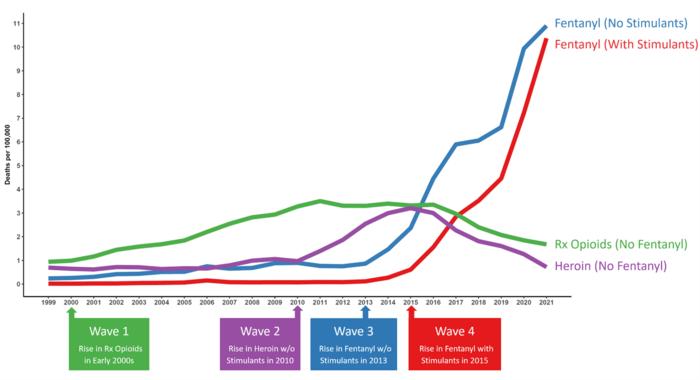New research published in the scientific journal Addiction has found that the proportion of US overdose deaths involving both fentanyl and stimulants has increased more than 50-fold since 2010, from 0.6% (235 deaths) in 2010 to 32.3% (34,429 deaths) in 2021. By 2021, stimulants (such as cocaine and methamphetamine) had become the most common drug class found in fentanyl-involved overdoses in every US state. This rise in fentanyl/stimulant fatalities constitutes the ‘fourth wave’ in the US’s long-running opioid overdose crisis –the death toll of which, continues to rise precipitously.
“We’re now seeing that the use of fentanyl together with stimulants is rapidly becoming the dominant force in the US overdose crisis,” says lead author Dr Joseph Friedman, of the University of California, Los Angeles. “Fentanyl has ushered in a polysubstance overdose crisis, meaning that people are mixing fentanyl with other drugs, like stimulants, but also countless other synthetic substances. This poses many health risks and new challenges for healthcare providers. We have data and medical expertise about treating opioid use disorders, but comparatively little experience with the combination of opioids and stimulants together, or opioids mixed with other drugs. This makes it hard to stabilize people medically who are withdrawing from polysubstance use.”
People consuming multiple substances may also be at increased risk of overdose, and many substances being mixed with fentanyl are not responsive to naloxone, the antidote to an opioid overdose.
The authors also found that fentanyl/stimulant overdose deaths disproportionately affect racial/ethnic minority communities in the US, including Black and African American people and Native American people. For instance, in 2021, the prevalence of stimulant involvement in fentanyl overdose deaths was 73% among 65 to 74-year-old Non-Hispanic Black or African American women living in the western US and 69% among 55 to 65-year-old Black or African American men living in the same area. The rate among the general US population in 2021 was 49%.
There are also geographical patterns to fentanyl/stimulant use. In the northeast US, fentanyl tends to be combined with cocaine; in the southern and western US, it appears most commonly with methamphetamine. Friedman says, “We suspect this pattern reflects the rising availability of, and preference for, low-cost, high-purity methamphetamine throughout the US, and the fact that the Northeast has a well-entrenched pattern of illicit cocaine use that has so far resisted the complete takeover by methamphetamine seen elsewhere in the country.”
The analysis illustrates how the US opioid crisis began with an increase in deaths from prescription opioids (wave 1) in the early 2000s and heroin (wave 2) in 2010. Around 2013, an increase in fentanyl overdoses signalled the third wave. The fourth wave – fentanyl overdoses with stimulants – began in 2015 and continues to grow.


